Then, my ol' buddy Jess Finley posted a great article on shoulder health and I figured I'd chime in on the subject, from a slightly different point of view. I am a fitness trainer by profession, and so I like to take a time out occasionally and look at the bio mechanics from a point of view other than that of a martial artist.
Over the 17 years I've been swinging steel I have noticed a lot of "sword elbow" in the HEMA/WMA community, and I realized that the injuries stem from similar sources: the mechanics of how folks stop their sword when they are at practice.
So, some time ago I took it upon myself to think of ways to prevent these injuries, both by specific strength building exercises and by taking a hard look at the mechanics of cutting. I found the exercise side to be pretty important (no surprise that a fitness trainer would prescribe exercise!). I'll cover that in the first part of the video below. Written descriptions of exercise can be excruciatingly technical.
Now, the deceleration problem was of more interest to me. I have never experienced these stress injuries in my elbows or shoulders. I thought I would have, as I have suffered some pretty nasty elbow injuries in my youth, and I still feel the effects of those mishaps to this day.
But those injuries inadvertently helped me avoid the stress of stopping the sword. My analysis: we don't collect our shoulders, which in turn prevents the energy of stopping the sword from moving beyond our shoulders and elbows. The energy instead is absorbed by larger, more durable muscles like the lats, and the erector spinae.
So in the attached video, I will show some exercises you can do at home by yourself to help out with strength, but also to encourage your body to have better posture and to keep the shoulders more collected and engaged at all times.
Staying focused on the upper body for a moment, the muscles I want to use to power the cut are my lat muscles, rather than the shoulders or the triceps/biceps. They are the biggest individual muscles on the upper body, and can absorb a lot of damage if your cut does not work out as planned (gets parried, hits armor, or misses entirely).
The entire core is also engaging, especially the front abs area. This offers more support to the spine, more power to the cut, and better transmission of energy to or from the legs.
Finally, it's important to remember that the end stage of a cut, right as contact is about to be made, is using my pulling muscles more than my pushing muscles. In part because if I hit meat, I want to shear through it in one smooth stroke. Also because if I hit steel or skull, it will let me strike harder and more cleanly exit the action.
Now for context, a little more about the cutting I do in this video.
My school teaches "traditional" martial arts, specifically the Armizare of Fiore di Libre, He was man who served a good part of his life as a mercenary. He had seen war, and so that idea must influence how I cut.
Every hit must matter.
Every hit must close a line.
Every fight ends with a thrust.
So, there are some things I do or don't do because that is in my head. Also, I mainly train to use a type XV sword, which are not as optimal for cutting as some other blade shapes. These swords were pretty common in Fiore's day and while they are not the best at cutting, they are great for striking both armored and unarmored targets.
Also, they are very good at creating IMPACT, which can change a fight in your favor whether the steel bites the target or not.

Picture the type XV on the right of the chart. Note they are very stabby, but not as optimized for cutting.
Here is a little video to explain. Enjoy.
(Sorry, I had to use voice over; the room was too loud to narrate)
https://youtu.be/krkDkZ1q63I